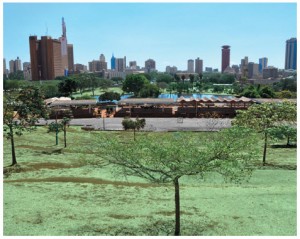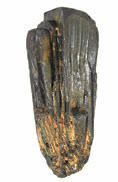
Africa’s survival depends on China. At the very least, sub-Saharan Africa’s rapid GDP growth rates — an estimated 6.3 percent this year and 5.1 percent last — rely on continued strong demand from China (growing this year at about 7.6 percent) for the vast commodity resources of the continent.
Africa has an abundance of the petroleum, natural gas, coal, iron ore, ferrochrome, copper, cobalt, cadmium, zinc, lead, diamonds, gold and coltan (a metallic ore used in electronics) that China desperately needs to feed its industries and satisfy domestic consumption and exports to profitable European and North American consumer markets. When Canadians purchase computers, cellphones, video games, inexpensive clothing, blankets, flip-flops and Christmas ornaments (among many other items that are often manufactured in China), they help Africa prosper.

Africa also supplies China with tropical hardwoods, soybeans and maize grown on Chinese-leased farms, fish taken legally and illegally from African waters, shoes made in Ethiopia from Ethiopian leather, carvings, wool fabrics from Mauritius, and, illicitly, ivory from endangered African elephant tusks and horns removed from the dwindling stock of endangered black and white rhinoceroses.
China, in turn, sends Africans cheap consumer goods, poultry, tourists, communications, farm and construction equipment, hats, televisions and a variety of technologically advanced items. But the balance of trade tips relentlessly in Africa’s favour.

Overall, total trade both ways between Africa and China amounted to about $200 billion last year, dwarfing European ($137 billion) and American ($85 billion) trade totals in 2013. Take Tanzania, a medium-sized country with which China has long had trade relations and which possesses very little oil and few other minerals: In 2013, China-Tanzanian trade amounted to $2.47 billion. U.S.-Tanzanian trade in the same year totalled $360 million despite tariff provisions for Tanzanian manufactured goods arriving in the U.S.

But China’s importance to Africa is as much due to what it builds as to what it buys. The colonial rulers of sub-Saharan Africa provided a basic infrastructure to most of their African dependencies before departing (or being pushed out) in the 1960s. Railways, roads, water and sanitation systems, airports and control towers, schools, hospitals, energy-generating facilities, and much more, were constructed in the colonies, often on the back of African taxes and exploited African labour. After independence, many sub-Saharan African countries greatly expanded their physical stock. Some constructed huge dams to provide hydropower, others focused on road improvements and schools; some built hospitals where none had hitherto existed, still others extended their rail networks or built refineries and upgraded airports.
That burst of energetic African construction petered out as commodity prices slumped, corruption escalated and foreign exchange reserves dwindled. Thus, for much of the undemocratic decades of the last century, and even more recently, most African nations failed to invest or reinvest in their fundamental infrastructures. Their urban water pipes corroded and leaked, as happened in Harare; their coal-fired electricity plants decayed, or their rails and rail ties became weak and unstable, as happened on the line from Lagos to Kano, Nigeria, or from Dar es Salaam, Tanzania, to Kabwe, Zambia.
About six years ago, when China’s drive to acquire African resources, especially oil, became obsessive, so it began to help Africans refurbish and upgrade what had by then become an infrastructure much too limited and unreliable to serve the growing general and more assertive new middle class populations of sub-Saharan Africa.
China has been building and rebuilding the roads of Africa: the new ring road around Nairobi, the lakeshore road in Malawi, highways from south to north in Nigeria, and so on — almost everywhere. Chinese authorities reconstructed the Tazara railway between Tanzania and Zambia (originally laid by China in the 1970s), totally rehabilitated the old Portuguese rail line between the Congolese and Zambian copperbelts and the Angolan port of Lobito, and upgraded several Nigerian rail lines. They are building a new railway between Mombasa and northwestern Kenya and northern Uganda (where there are oil deposits) and they are finishing a rail line between Addis Ababa and Djibouti.
China has constructed ports on both sides of Africa and on its offshore islands, soccer stadiums, party headquarters, hospitals, scientific research centres, municipal waste depots and thermal power plants. China has even built and donated the skyscraper headquarters of the African Union in Addis Ababa. China has extended airports, supplied control towers, given satellite receiving stations and laid pipelines (as in the Sudan and South Sudan). Overall, it has responded to Africa’s requests with alacrity, bidding well and mostly successfully, for construction contracts.
In no sector have the Chinese been more critical than in the construction of dams to provide hydropower for local industry, local consumption and potential export. China is busily building the dams that the World Bank and other Western donors have disdained on account of serious environmental concerns or disagreements with host governments about economic viability. China has gone ahead and constructed dams regardless, especially very suspect projects in eastern Mozambique, western Nigeria, central Ghana, eastern Gabon, eastern Republic of Congo, southern Ethiopia, the northern Sudan, central Zambia and western Uganda.
The Grand Renaissance Dam across the Blue Nile River in Ethiopia will flood 1,700 square kilometres of forest and impound waters on which the Sudan and Egypt, downstream, have long depended for agriculture. In southern Ethiopia, China is funding a third Gilgel Gebe Dam across the Omo River despite World Bank concerns that the project will adversely affect local agriculturalists and their fertile lands.
Chinese-constructed dams in neighbouring Sudan, near the second, third and fourth cataracts of the White Nile River, will destroy ancient Nubian archeological treasures and displace many thousands of people. In Mozambique, when the Chinese begin erecting the Mphanda Nkuwa Dam across the lower Zambezi River, it will accelerate downstream environmental damage by causing daily fluctuations in river levels and by reducing the natural flow of river sediments that are critical to the health of the wide Zambezi Delta.
Africans pay for all of these infrastructural improvements by pledging oil and gas shipments, copper or iron ore exports and other commodities. Sometimes China writes off the loans that undergird these endeavours; sometimes it provides soft loans and extends long lines of credit. Even if poor African countries end up paying real cash, they do obtain the new roads and other infrastructure that their expanding populations require, and some among the ruling elites profit from rents, kickbacks and tangible largesse. China, of course, always gains the access it craves, often at favourable prices. What China rarely does, however, is transfer technology to locals.
Nor does it routinely employ African middle managers, or even foremen. Sometimes it even imports masses of pick and shovel labourers directly from China to work on the roads or down the mines. Africans have complained, but their leaders have largely been content to cut deals with China and overlook China’s failures on the employment front (most sub-Saharan African countries have unemployment rates of 50 percent or more). Occasionally, China ends up controlling an industry or a commercial sector, undercutting local entrepreneurs.
There have been a few more outright failures, too: A Chinese-constructed hospital in Angola had to be torn down, a road in Zambia collapsed, a coal-fired plant in Botswana never worked well, a refinery in Cameroon polluted the atmosphere more than anticipated and a mine in Gabon produced poorly. There are others.
But China’s biggest failings have been those of omission. Professing never to interfere in the politics or foreign policies of African nations, and preferring routinely to deal with the ruling classes in one African country after another, China has professed to ignore dictatorships, human rights violators and violations, corrupt practices and vast fields of injustice. In that manner, China supplied the aircraft, guns and ammunition that Sudanese government forces used to kill civilians in Darfur, Blue Nile and the Nuba Mountains and that Zimbabwean police and soldiers employed against their countrymen. China supports the wildly corrupt coterie that controls Angola, backs similarly distasteful regimes in Cameroon and Equatorial Guinea, consorts with unsavoury politicians in places such as Malawi and Sao Tome, and everywhere is seemingly content to let African ruling classes use Chinese largesse for themselves instead of for their countrymen.
China is bigger and wealthier, and has more leverage in negotiations than any single African country — hence the ease with which it has developed secure relations with nearly every state in sub-Saharan Africa. China also has embassies and military attachés in many more capitals than does the United States. It also supplies Confucius Institutes to several African countries, teaches Mandarin in many African cities, seeds Kenyan and other African television news with official Chinese propaganda and covers Africa on its overseas news service. These are all effective bilateral arrangements; Africa has not yet negotiated with China multilaterally, on behalf of all of Africa or at least one of the African sub-regional entities such as the 15-member ECOWAS (Economic Community of Western African States). Both options would give Africa much more leverage to influence the scope and quality of the Sino-African interaction.
The Chinese are not 21st-Century colonialists. They have not come to Africa to uplift the locals, to evangelise, to end the slave trade or to find themselves. Africa is not an existential endeavour for the Chinese, although more than one million have already decided to settle permanently in Africa as farmers, fishermen, plantation owners, bankers, educators and serial entrepreneurs. For them, it is all about profits and engines of growth.
The 19th- and 20th-Century colonialists came to Africa as a ruling, largely European, class and, in key countries, usurped valuable land to grow cash crops. Everywhere, they introduced a foreign culture to Africans. Although the Chinese who are now settling in Africa may eventually produce a Sino-African Chinese ethnicity to add to the many peoples of modern Africa, they are rarely being permitted by African governments to alienate agricultural land permanently or to acquire (rather than to purchase at world prices) the resources that are so central to contemporary Chinese-African commerce. Africans, in other words, will not again lose their patrimony.
As Africa’s population soars in this century almost to equal China and India’s combined, only China can supply the income stream essential to support the enhanced social services and demographic dividend required if Africa, over the next few decades, is going to emerge from poverty and poor outcomes to take its rightful, strong position in a troubled world.
Robert I. Rotberg is a senior fellow at the Centre for International Governance Innovation and fellow at the Woodrow Wilson International Centre for Scholars.He is the founding director of Harvard Kennedy School’s Program on Intrastate Conflict and president emeritus of the World Peace Foundation.





